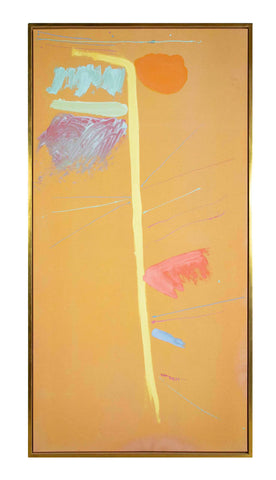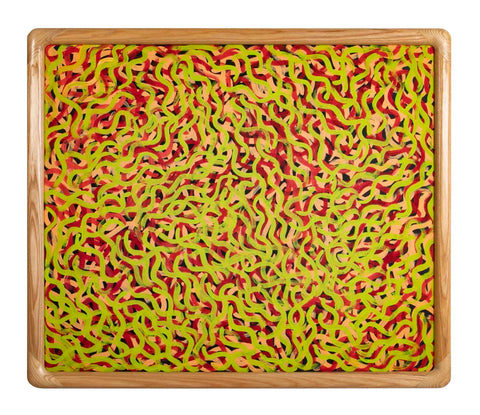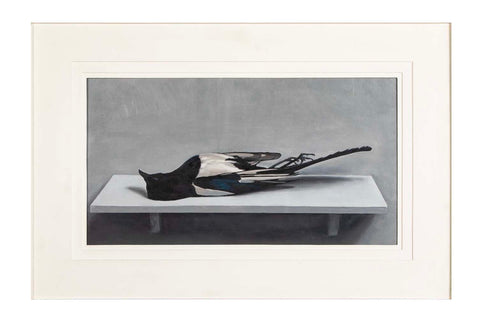
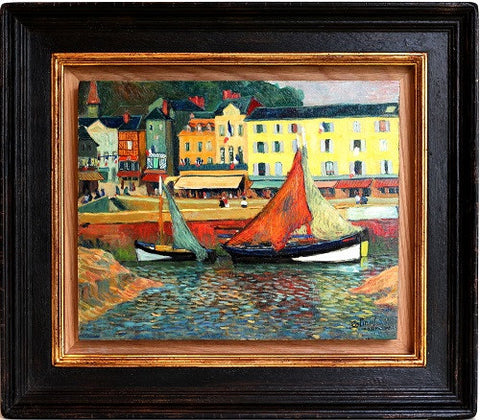
Fontainebleau Fine Art
COLINUS, Emile (French, 1884-1966) "Harbor of Honfleur", Normandy
$0.00
Call For Location | 203-325-8070
"Harbor of Honfleur", Normandy
A pupil of the Acad̩mie de Montmartre Colinus received a solid academic training by Fernand Cormon with the emphasis on Realism. His apprenticeship took a new direction when Andr̩ Lhote (1885-1962) a cubist painter, became director of the Acad̩mie in 1907 and initiated Colinus into the most recent trends of modern art, which had turned towards a simplification of forms. The paintings that the artist showed at the Salon des Ind̩pendents from 1925 synthesize the legacy of Cormon and of Lhote in a personal way.
Colinus style is characterized by understated drawing and a fluid line. At this time his palette was composed of soft and warm colors, which didn't give a hint of the brilliant hues he would use later on. The colors are given a clean, black outline that shows evidence of borrowing from the cloisonnism popularized by the painters of Pont-Aven lead by Paul Gauguin. Colinus' cloisonnist painting was to remain his signature style.
In 1959, the artist exhibited two canvases at the Salon des Ind̩pendents painted in Honfleur, Normandy.
One of them shows the Port de la Lieutenance a picturesque quay situated at the end of the old harbor of the maritime port. The painting has stylistic affinities with the Honfleur paintings of Henri de Saint-Delis (1878-1949), who settled in the town in 1920.
Colinus' rare paintings of Honfleur have this same youthful candor, where the sails of the fishing boats serve as a pretext for the use of pure color, as with Matisse, Derain, De Vlaminck and Van Dongen during their fauvist period.
Fauvism, a term coined after the word les Fauves (French for "the wild beasts"), a group of early twentieth-century Modern artists whose works emphasized painterly qualities and strong, loud-as-a-roar colors over the representational or realistic values retained by Impressionism.
The paintings of the Fauves were characterized by seemingly wild brush work and strident colors, while their subject matter had a high degree of simplification and abstraction. Fauvism can be classified as an extreme development of Van Gogh's Post-Impressionism fused with the pointillism of Seurat and other Neo-Impressionist painters, in particular Paul Signac. Other key influences were Paul C̩zanne and Paul Gauguin, with their use of areas of saturated colors.
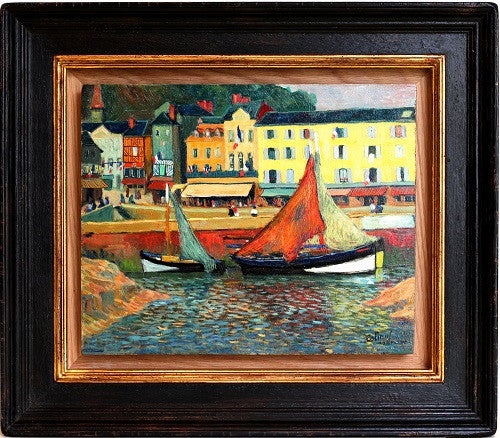

Fontainebleau Fine Art
COLINUS, Emile (French, 1884-1966) "Harbor of Honfleur", Normandy
"Harbor of Honfleur", Normandy
A pupil of the Acad̩mie de Montmartre Colinus received a solid academic training by Fernand Cormon with the emphasis on Realism. His apprenticeship took a new direction when Andr̩ Lhote (1885-1962) a cubist painter, became director of the Acad̩mie in 1907 and initiated Colinus into the most recent trends of modern art, which had turned towards a simplification of forms. The paintings that the artist showed at the Salon des Ind̩pendents from 1925 synthesize the legacy of Cormon and of Lhote in a personal way.
Colinus style is characterized by understated drawing and a fluid line. At this time his palette was composed of soft and warm colors, which didn't give a hint of the brilliant hues he would use later on. The colors are given a clean, black outline that shows evidence of borrowing from the cloisonnism popularized by the painters of Pont-Aven lead by Paul Gauguin. Colinus' cloisonnist painting was to remain his signature style.
In 1959, the artist exhibited two canvases at the Salon des Ind̩pendents painted in Honfleur, Normandy.
One of them shows the Port de la Lieutenance a picturesque quay situated at the end of the old harbor of the maritime port. The painting has stylistic affinities with the Honfleur paintings of Henri de Saint-Delis (1878-1949), who settled in the town in 1920.
Colinus' rare paintings of Honfleur have this same youthful candor, where the sails of the fishing boats serve as a pretext for the use of pure color, as with Matisse, Derain, De Vlaminck and Van Dongen during their fauvist period.
Fauvism, a term coined after the word les Fauves (French for "the wild beasts"), a group of early twentieth-century Modern artists whose works emphasized painterly qualities and strong, loud-as-a-roar colors over the representational or realistic values retained by Impressionism.
The paintings of the Fauves were characterized by seemingly wild brush work and strident colors, while their subject matter had a high degree of simplification and abstraction. Fauvism can be classified as an extreme development of Van Gogh's Post-Impressionism fused with the pointillism of Seurat and other Neo-Impressionist painters, in particular Paul Signac. Other key influences were Paul C̩zanne and Paul Gauguin, with their use of areas of saturated colors.
